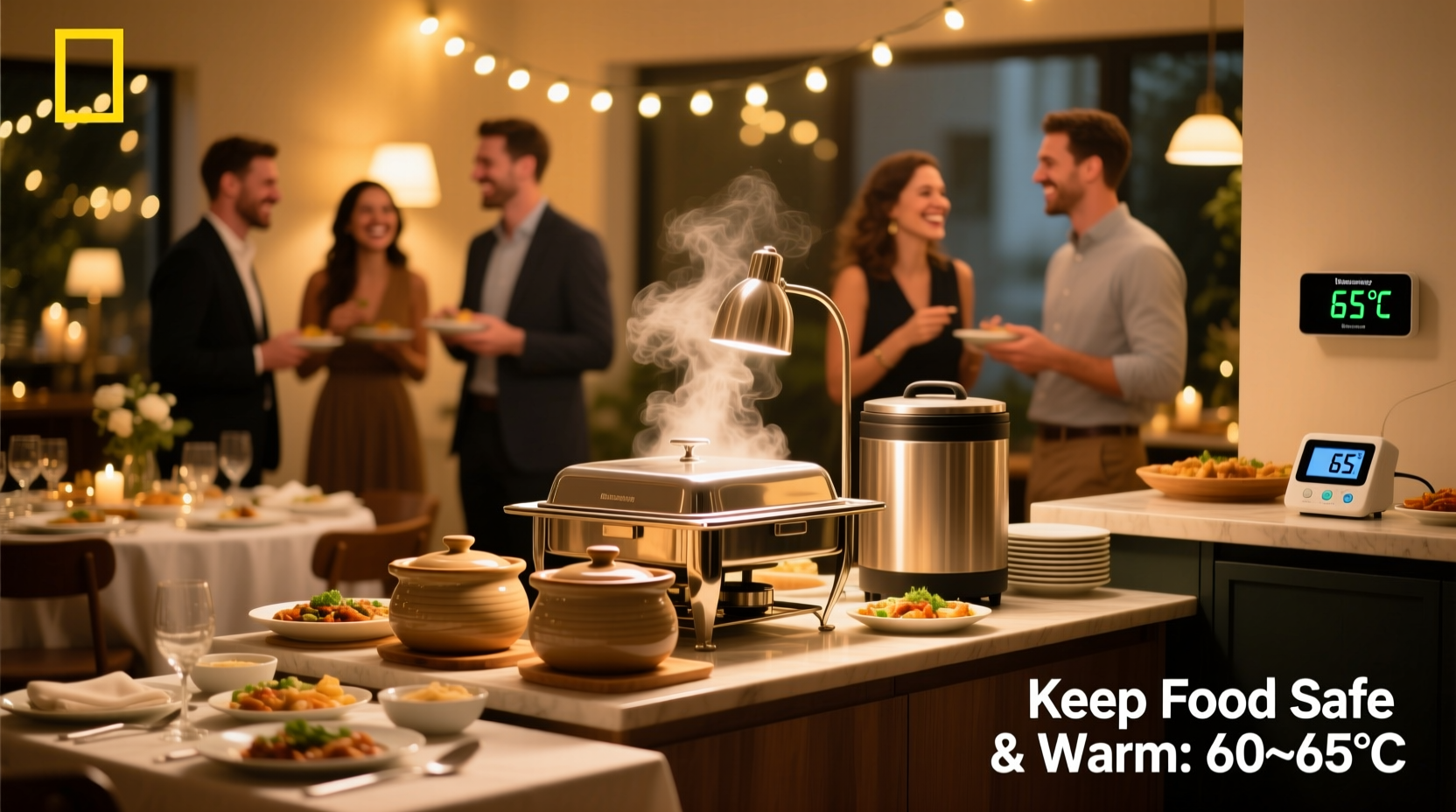Nothing ruins a party faster than cold, unappetizing food. Whether you're hosting an elegant dinner gathering or a casual backyard barbecue, keeping your dishes at the perfect temperature is essential for both flavor and food safety. As someone who's worked in professional kitchens and helped countless home cooks perfect their entertaining skills, I've developed practical solutions that actually work in real-world party scenarios.
Why Food Temperature Matters Beyond Just Taste
Keeping food warm isn't just about serving hot dishes—it's a critical food safety issue. According to the FDA Food Code, hot foods must maintain temperatures of 140°F (60°C) or higher to stay out of the 'danger zone' where bacteria multiply rapidly. The temperature danger zone spans from 40°F to 140°F (4°C to 60°C), and food should never remain in this range for more than two hours (or one hour if your party space exceeds 90°F/32°C).
| Temperature Range | Bacterial Growth Rate | Safe Holding Time |
|---|---|---|
| Below 40°F (4°C) | Slowed significantly | Safe for extended periods |
| 40°F-70°F (4°C-21°C) | Doubles every 20 minutes | Maximum 1 hour |
| 70°F-125°F (21°C-52°C) | Exponential growth | Maximum 30 minutes |
| Above 140°F (60°C) | Stopped | Safe indefinitely |
Pre-Party Preparation: Setting Yourself Up for Success
Successful food warming starts long before your guests arrive. Smart preparation prevents last-minute scrambling and ensures your dishes stay at safe temperatures throughout the event.
Menu Planning with Warmability in Mind
Not all dishes hold up equally well when kept warm. Structure your menu around foods that maintain quality when held at serving temperature:
- Best candidates: Stews, soups, chili, casseroles, and braised meats actually improve with extended warming
- Good candidates: Roasted vegetables, meatloaf, and baked pasta dishes (with proper covering)
- Challenging items: Delicate fish, fried foods, and dishes with creamy sauces require special attention
Equipment Checklist You Already Own
You likely have more warming tools than you realize. Before renting or buying specialized equipment, assess what's already in your kitchen:
- Slow cookers (most have 'warm' settings that maintain 145-165°F/63-74°C)
- Oven with precise temperature control
- Insulated beverage containers (for sauces and gravies)
- Heavy-duty aluminum trays (for professional-style presentation)
- Thick towels and blankets (for insulation)
Proven Methods for Keeping Food Warm During Your Party
Chafing Dishes: The Buffet Standard
Chafing dishes with fuel cans remain the gold standard for buffet-style parties. When using them properly:
- Preheat the water reservoir before adding food
- Maintain water level (evaporation reduces effectiveness)
- Use high-quality fuel cans (standard cans provide 2-3 hours of heat)
- Position dishes away from drafts and high-traffic areas
For extended events, have backup fuel cans ready to swap in when needed. This method reliably maintains temperatures between 140-160°F (60-71°C), keeping food safely out of the danger zone.

Slow Cookers: Your Secret Weapon
Most home cooks underestimate what their slow cookers can do on 'warm' setting. Modern models maintain temperatures between 145-165°F (63-74°C), perfect for food safety. For best results:
- Fill slow cookers at least half full to maintain consistent temperature
- Stir food occasionally to distribute heat evenly
- Keep the lid on except when serving (each opening drops temperature significantly)
- Place on a heat-resistant surface away from flammable materials
The Oven Method: Controlled Environment
Your oven provides the most temperature-controlled environment for keeping food warm, but requires careful monitoring:
- Set oven to its lowest setting (usually 170-200°F/77-93°C)
- Place food in covered dishes to prevent drying
- Use an oven thermometer for accuracy (oven dials are often unreliable)
- Check temperatures every 30 minutes with a food thermometer
This method works best for smaller gatherings where you can monitor the oven closely. Never leave food unattended in an oven for extended periods.
Food-Specific Warming Strategies
Different foods require tailored approaches to maintain quality while staying safe. Understanding these nuances prevents common problems like drying out or texture changes.
Sauces, Gravies, and Liquids
Liquid-based items are easiest to keep warm but most prone to scorching. Use these techniques:
- Transfer to insulated beverage containers (like large thermoses)
- If using a slow cooker, set to lowest setting and stir occasionally
- Add a small amount of water if reduction occurs during extended warming
- Maintain between 140-160°F (60-71°C) for optimal safety and texture
Meats and Proteins
Proteins present the biggest food safety concerns but are also most vulnerable to drying out:
- Keep meats in their natural juices or add broth to prevent drying
- Cover with foil when using oven warming method
- For sliced meats, arrange in a single layer with space between pieces
- Check internal temperature periodically (should remain above 140°F/60°C)
Troubleshooting Common Warming Problems
When Food Starts Drying Out
Drying is the most frequent issue with extended warming. Counteract it by:
- Adding small amounts of broth, water, or sauce periodically
- Using tight-fitting lids or covering with foil
- Placing a damp towel between the lid and food container
- For meats, basting every 30-60 minutes
Temperature Fluctuations
If you notice temperatures dropping below 140°F (60°C):
- Combine warming methods (e.g., slow cooker inside a chafing dish)
- Reduce the amount of food in each container (less volume heats more evenly)
- Move containers away from drafts or air conditioning vents
- Refresh fuel sources before they're completely depleted
When to Refresh Food Completely
Even with perfect warming techniques, food quality degrades over time. Follow these guidelines for optimal results:
- Fresh batches every 2 hours for best quality (required for food safety)
- Discard any food that's been below 140°F (60°C) for more than 2 hours
- Have backup portions ready to rotate in without guests noticing
- For large events, consider a 'just-in-time' cooking approach for certain dishes
Remember that food safety should always trump presentation concerns. It's better to refresh dishes frequently than risk serving unsafe food.











 浙公网安备
33010002000092号
浙公网安备
33010002000092号 浙B2-20120091-4
浙B2-20120091-4